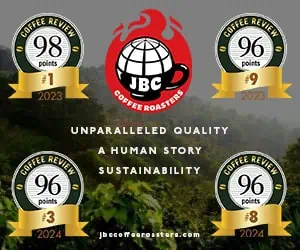Evaluating coffees apart from the people who grow them is sometimes difficult. It becomes particularly difficult when the people in question are as charming and lavishly hospitable as the Brazilian growers whom I visited last month.
I ate very well, shared much generous laughter, and here and there cupped some very impressive coffees. I was moving in the learned wake of George Howell, whom some readers know as one of the founders of the specialty coffee movement (and whom insiders know as one of the world’s most picky cuppers.)
As I looked back on the coffee part of the trip, two questions occurred to me: First, was I so influenced by Brazilian charm that I was too generous in my evaluation of those coffees I considered very impressive? (Or, since I was cupping with George Howell, too hard on the other not-so-impressive coffees?) Second, were any of the impressive coffees making it back to the States, or were we stuck with the equivalent of the also-rans that inhabited the cupping tables along with the good ones?
Because, until American cuppers learn to appreciate the best Brazils on their own terms as Italian cuppers already do, and until we decide to pay a premium for those best Brazils rather than simply bottom-feed for cheap-but-decent blender, it seems unlikely that the best of the Brazils I tasted will end up available to American aficionados.
Thus the theme of this month’s cupping: The state of Brazils in the United States. I emphasize the United States. By tasting Brazils available here we probably learn very little about the state of Brazils in Brazil, or in Italy, or in Japan. First, the Brazil coffee-growing scene is one of the most complex and various in the world, perhaps the most complex and various, and only a very small part of that variety makes it to the United States. Second, the best coffees I tasted already had been purchased by buyers in other parts of the world, particularly Italy.
The one arena in which Brazils have made a small impression on American specialty coffee consciousness is in espressos. After all, we can’t help but be impressed by the fact that Italy’s most sophisticated espresso blends are entirely comprised of Brazils.
Why the Italian devotion to Brazils when American specialty people avoid or patronize them? Mainly because Italians try to achieve the deep, rounded sweetness of a good espresso by choosing deep, rounded, sweet coffees rather than attempting to deepen and sweeten sharp, high-grown, acidy coffees by roasting them dark. First, Brazils are relatively low-grown, though not excessively low-grown, which makes them lively but not powerfully acidy. (Acidy notes tend to come across as overbearing and sharp in espresso.) Second, traditional Brazils, the ones Italians most admire, are dry-processed, meaning the coffee is dried inside the fruit rather than dried after the fruit has been removed. This practice allows sugars from the fruit to influence the taste of the coffee, turning it (at best) round, full-bodied and sweet, all desirable characteristics for espresso in the Italian mode.
Unfortunately, dry-processing is a tricky business, particularly when much of the coffee tends to be strip-picked or machine-picked as it is in Brazil, rather than selectively hand-picked as it is in other parts of the world where farms are smaller and labor costs are lower. Two things can go wrong with strip-picked, dry-processed coffee: First, some of the coffee fruit ferments and/or develops molds as it dries, imparting one of several variations of hard, harsh tastes. Secondly, otherwise defect-free coffee can develop tart, astringent tones deriving, I’m told, from too many unripe cherries in the mix of drying fruit. In the first case (ferment/mold) we’re talking defect; in the second (astringency from unripe cherries) weakness rather than defect.
I have to report that the majority of coffees I tasted in Brazil suffered from one or both of these faults. However, the best and cleanest exhibited an extraordinary and distinctive profile: fragrantly sweet, round, gently spicy. Moreover, the finest from trees of the classic Bourbon variety tended to complicate the sweet spiciness with a low-toned but gently powerful acidity.
So what do we have available in the United States today for those curious palates who want to experience some of that sweetness, fragrance, etc.?Not a lot, but something. First of all, it was difficult to even find straight Brazils for sale, not to mention impossible to find an American espresso blend that was entirely made up of Brazils in the Italian style. However, my colleague Ron Walters did turn up a few unblended Brazils roasted for drip or press-pot brewing, plus some espresso blends based on Brazils.
Most of the single-origin Brazils in the cupping were not presented as estate coffees, but rather as “Bourbon Santos,” meaning the coffee came from trees of the heirloom Bourbon variety, but could have been produced in any one of the three very large growing regions included in the Santos designation. These generic Bourbon Santos probably were processed using the traditional Brazilian dry or natural method.
Two of the three estate coffees came from the only Brazilian estate to create a presence on the American specialty market: Vista Alegre, which promotes its coffees as the ultimate in natural-processing: not only sun-dried, but dried on the trees. The dried-on-the-trees approach is a wonderful marketing angle, but both the Vista Alegres in this particular cupping exhibited the hardness that comes when the fruit ferments or is invaded by mold as it dries.
On the other hand, the Blue de Brasil, an organic coffee produced on one of two related estates, was a much better representative of the Brazil profile. Based purely on taste, I would guess that this coffee comes from trees of the Mondo Novo variety rather than the Bourbon: it has the exquisitely creamy body, low-toned acidity, and blooming, spicy sweetness of the best Mondo Novos I cupped in Brazil. Unfortunately, it also displays the barest hint of hardness, probably undetectable to most palates (except George Howell’s). Still, an excellent introduction to the possibility of one style of fine Brazil coffee.
For the somewhat more acidy Bourbon style, try the Armeno Bourbon Santos, which displayed a touch more authority to go with the body and sweetness. And for the occasional Brazil I tasted with floral or citrus tones, brew the First Colony Bourbon Santos. The somewhat brighter, lighter, floral character of this coffee may be owing to a variation in processing. Perhaps, rather than a natural or dry-processed coffee, it is either a wet-processed or a “pulped natural” coffee (meaning the skins are removed from the coffee fruit before drying, but the fleshy part of the fruit is allowed to dry on the bean).
The one Brazil coffee experience this cupping did not recapitulate for me was the sweet espresso. I recall tasting one espresso in particular, a straight coffee from the Mogiana region in Sao Paulo State, that was absolutely astounding in its natural sweetness and fragrance. The inherent sweetness of a fine espresso is much different from the sweetness that comes from dumping sugar into the demitasse, by the way — it is complex, resonant and inevitable rather than cloying and simple.
The Espresso di Carlo from Mr. Espresso was an excellent blend, but far too dramatic to embody the rounded, elegant possibility of the finest Brazils. As for the other two espresso blends in the cupping, the presence of robustas and additional coffees pretty much made the contribution of the Brazil components moot.
Still, the three single-origin Brazils I recommend make an excellent introduction to the potential pleasures of Brazil specialty coffees. Unfortunately, I can’t bring you the other experiences that made my trip such a delight: the busy birds that built little mud houses on branches, the big skies and rolling hills, the (literally) twenty kinds of fresh fruit juices, and above all, my hosts’ generosity of spirit.










